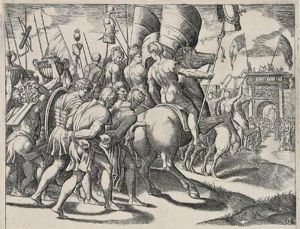Severo Da Ravenna Paintings
Severo da Ravenna, also known as Severo di Domenico Calzetta, was an Italian sculptor, active during the Renaissance period, particularly known for his bronze statuettes. Born around 1495 in Ravenna, his precise date of birth remains uncertain. Despite the moniker 'da Ravenna,' which indicates his origin, much of Severo's professional life unfolded in Padua, which was a vibrant artistic center at the time, influenced by the presence of Donatello earlier in the 15th century. Severo's work followed in the tradition of the Paduan school and carried the influence of Donatello's innovations in bronze casting and his expressive realism.
Severo da Ravenna's career flourished in the early 16th century, a period when the demand for small bronze statuettes grew among patrons who sought to decorate their homes with classical and contemporary art. Severo's bronzes were prized for their dynamic compositions, often depicting mythological or allegorical figures, and were noted for their intricate detail and sense of movement. He was adept at the lost-wax casting method, which allowed for fine textural effects and complex forms. Severo's figures frequently exhibited a whimsical or humorous character, distinguishing his work from that of his contemporaries.
Some of the most renowned pieces attributed to Severo include his depictions of Marsyas, Pan, and various satyrs, which exhibit a playful interaction with the natural world and an exceptional level of craftsmanship. His works were influential in spreading the Renaissance style across Europe, especially among collectors and other artists, who admired and imitated his bronzes.
Severo's exact date of death is also a matter of some uncertainty, but it is believed he died around 1543. The legacy of Severo da Ravenna lies in his mastery of small-scale bronzes, which continued to be celebrated and collected long after his death, contributing to the enduring appreciation of Renaissance bronze sculpture. His works can be found in several major museums around the world, where they continue to be studied and admired for their artistry and historical significance.
